A Comparative Modeling Study of Supertyphoons Mangkhut and Yutu (2018) Past the Philippines with Ocean-Coupled HWRF
Abstract
1. Introduction
2. Model Configuration and Numerical Experiments
2.1. Overview of Two Supertyphoons
2.2. The Ocean-Coupled Model
2.3. Data Description
2.4. Numerical Experiments
2.5. PV Tendency Budget
3. Simulation Results of Sensitivity Experiments
3.1. Sensitivity to Physics Schemes
3.2. Ocean Condition and SST Cooling
3.3. Sensitivity to Air–Sea Coupling
3.4. Sensitivity to Initial Ocean Temperature and Philippines Terrain
3.5. Sensitivity to Initial Time
4. Coupled Simulations and Track Deflection
4.1. Simulated Precipitation
4.2. Typhoon Circulation and Convection
4.3. PV Tendency Budget
5. Conclusions
Author Contributions
Funding
Institutional Review Board Statement
Informed Consent Statement
Data Availability Statement
Acknowledgments
Conflicts of Interest
Appendix A
Sensitivity to Physics Schemes
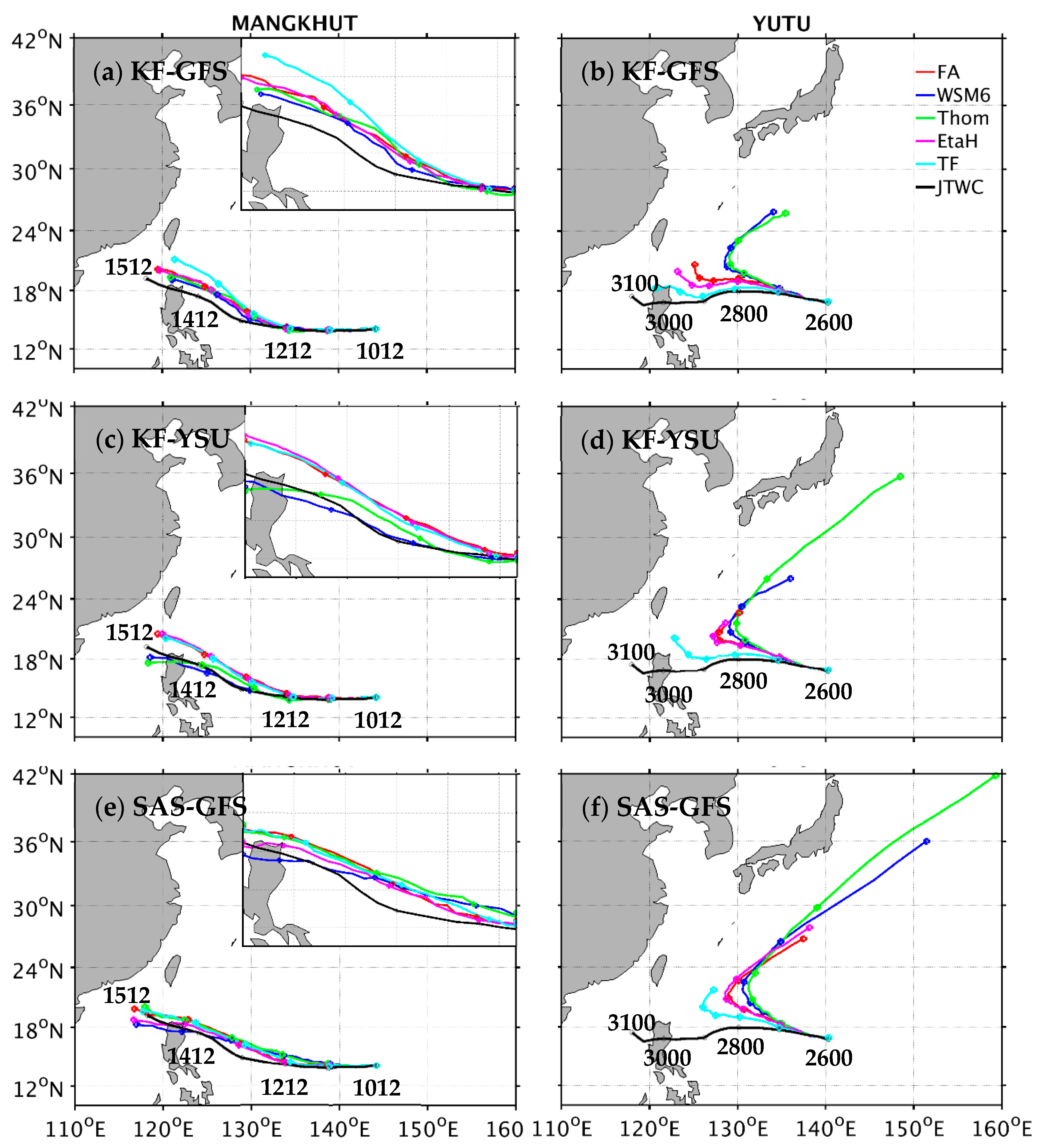
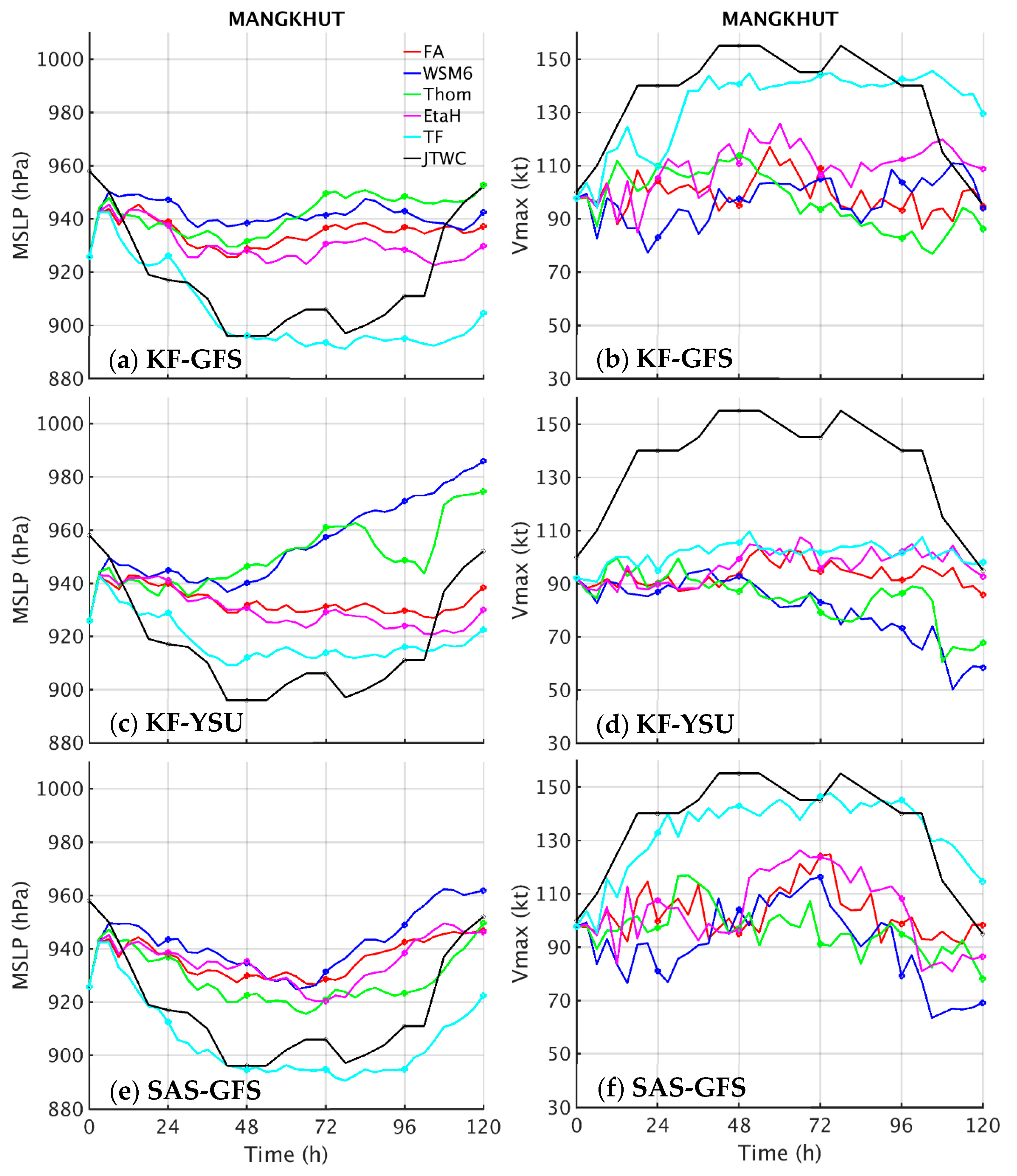
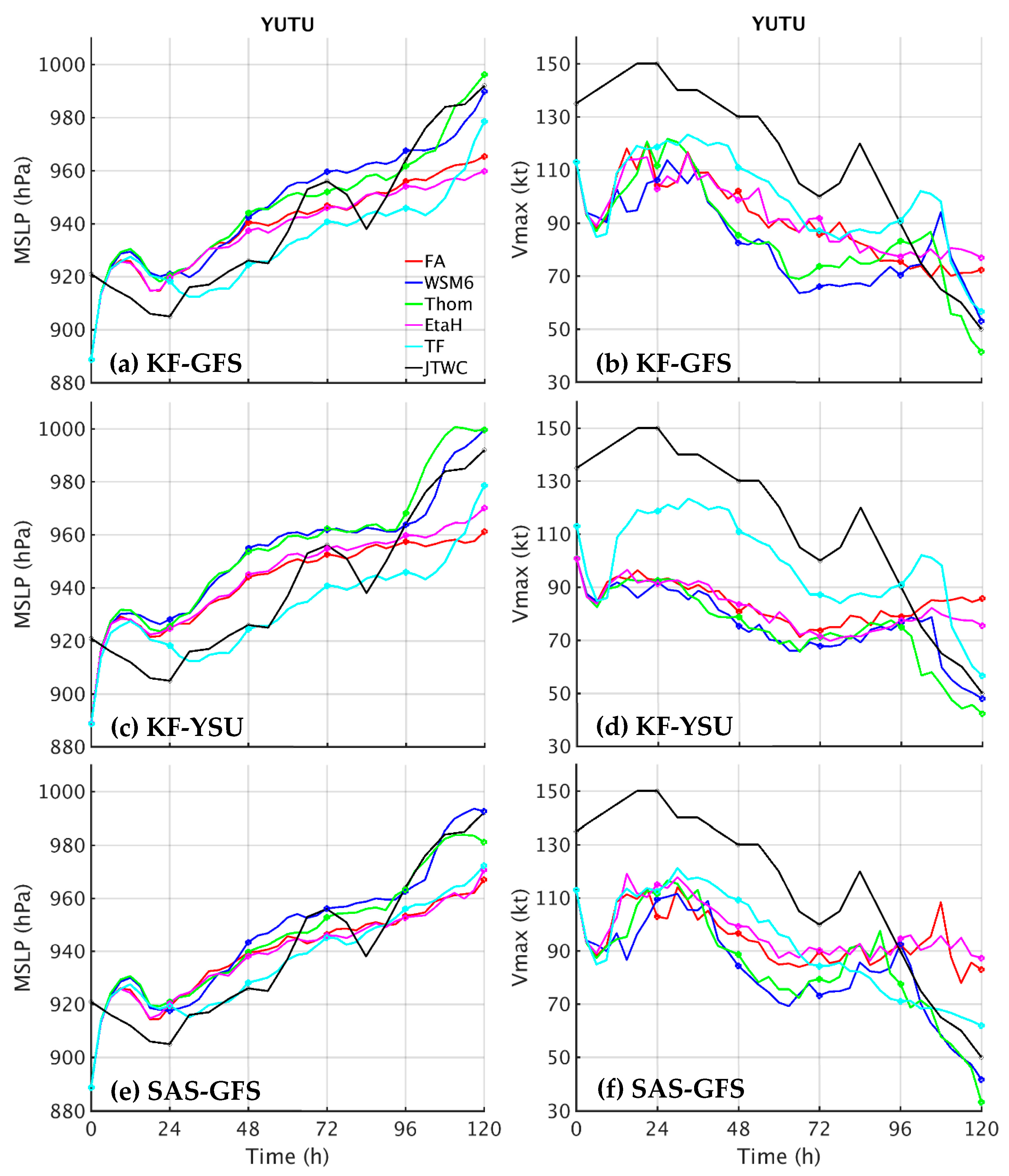
References
- Wu, L.; Wang, B.; Braun, S.A. Impacts of air–sea interaction on tropical cyclone track and intensity. Mon. Weather Rev. 2005, 133, 3299–3314. [Google Scholar] [CrossRef]
- Davis, C.; Wang, W.; Chen, S.S.; Chen, Y.; Corbosiero, K.; DeMaria, M.; Dudhia, J.; Holland, G.; Klemp, J.; Michalakes, J.; et al. Prediction of landfalling hurricanes with the advanced hurricane WRF model. Mon. Weather Rev. 2008, 136, 1990–2005. [Google Scholar] [CrossRef]
- Huang, Y.H.; Wu, C.C.; Wang, Y. The influence of island topography on typhoon track deflection. Mon. Weather Rev. 2011, 139, 1708–1727. [Google Scholar] [CrossRef]
- Kieu, Q.C.; Nguyen, M.T.; Hoang, T.M.; Ngo, D.T. Sensitivity of the track and intensity forecasts of Typhoon Megi (2010) to satellite-derived atmospheric motion vectors with the ensemble kalman filter. J. Atmos. Ocean. Technol. 2012, 29, 1794–1810. [Google Scholar] [CrossRef]
- Yun, K.S.; Chan, J.C.L.; Ha, K.J. Effects of SST magnitude and gradient on typhoon tracks around East Asia: A case study for Typhoon Maemi (2003). Atmos. Res. 2012, 109, 36–51. [Google Scholar] [CrossRef]
- Choi, Y.; Yun, K.S.; Ha, K.J.; Kim, K.Y.; Yoon, S.J.; Chan, J.C.L. Effects of asymmetric SST distribution on straight-moving Typhoon Ewiniar (2006) and recurving Typhoon Maemi (2003). Mon. Weather Rev. 2013, 141, 3950–3967. [Google Scholar] [CrossRef]
- Li, X. Sensitivity of WRF simulated typhoon track and intensity over the Northwest Pacific Ocean to cumulus schemes. Sci. China Earth Sci. 2013, 56, 270–281. [Google Scholar] [CrossRef]
- Wu, C.-C.; Tu, W.-T.; Pun, I.-F.; Lin, I.-I.; Peng, M.S. Tropical cyclone-ocean interaction in Typhoon Megi (2010)—A synergy study based on ITOP observations and atmosphere-ocean coupled model simulations. J. Geophys. Res. Atmos. 2015, 121, 153–167. [Google Scholar] [CrossRef]
- Katsube, K.; Inatsu, M. Response of tropical cyclone tracks to sea surface temperature in the western North Pacific. J. Clim. 2016, 29, 1955–1975. [Google Scholar] [CrossRef]
- Srinivas, C.V.; Mohan, G.M.; Naidu, C.V.; Baskaran, R.; Venkatraman, B. Impact of air-sea coupling on the simulation of tropical cyclones in the North Indian Ocean using a simple 3-D ocean model coupled to ARW. J. Geophys. Res. Atmos. 2016, 121, 9400–9421. [Google Scholar] [CrossRef]
- Bender, M.A.; Marchok, T.P.; Sampson, C.R.; Knaff, J.A.; Morin, M.J. Impact of storm size on prediction of storm track and intensity using the 2016 operational GFDL hurricane model. Weather Forecast. 2017, 32, 1491–1508. [Google Scholar] [CrossRef]
- Hsu, L.-H.; Su, S.-H.; Fovell, R.G.; Kuo, H.-C. On typhoon track deflections near the east coast of Taiwan. Mon. Weather Rev. 2018, 146, 1495–1510. [Google Scholar] [CrossRef]
- Chang, S.W.; Madala, R.V. Numerical simulation of the influence of sea surface temperature on translating tropical cyclones. J. Atmos. Sci. 1980, 37, 2617–2630. [Google Scholar] [CrossRef][Green Version]
- Sun, J.; Oey, L.Y.; Chang, R.; Xu, F.; Huang, S.-M. Ocean response to typhoon Nuri (2008) in western Pacific and South China Sea. Ocean Dyn. 2015, 65, 735–749. [Google Scholar] [CrossRef]
- Lin, Y.L.; Chen, S.Y.; Hill, C.M.; Huang, C.Y. Control parameters for track continuity and deflection associated with tropical cyclones over a mesoscale mountain. J. Atmos. Sci. 2005, 62, 1849–1866. [Google Scholar] [CrossRef]
- Tang, C.K.; Chan, J.C.L. Idealized simulations of the effect of Taiwan and Philippines topographies on tropical cyclone tracks. Q. J. R. Meteorol. Soc. 2014, 140, 1578–1589. [Google Scholar] [CrossRef]
- Huang, C.Y.; Chen, C.A.; Chen, S.H.; Nolan, D.S. On the upstream track deflection of tropical cyclones past a mountain range: Idealized experiments. J. Atmos. Sci. 2016, 73, 3157–3180. [Google Scholar] [CrossRef][Green Version]
- Li, D.-Y.; Huang, C.-Y. The influences of orography and ocean on track of Typhoon Megi (2016) past Taiwan as identified by HWRF. J. Geophys. Res. Atmos. 2018, 123, 11492–11517. [Google Scholar] [CrossRef]
- Huang, C.-Y.; Juan, T.-C.; Kuo, H.-C.; Chen, J.-H. Track deflection of Typhoon Maria (2018) during a westbound passage offshore of northern Taiwan: Topographic influence. Mon. Weather Rev. 2020, 148, 4519–4544. [Google Scholar] [CrossRef]
- Mandal, M.; Mohanty, U.C.; Raman, S. A Study on the impact of parameterization of physical processes on prediction of tropical cyclones over the Bay of Bengal with NCAR/PSU mesoscale model. Nat. Hazards 2004, 31, 391–414. [Google Scholar] [CrossRef]
- Srinivas, C.V.; Venkatesan, R.; Bhaskar Rao, D.V.; Prasad, D.H. Numerical simulation of Andhra severe cyclone (2003): Model sensitivity to boundary layer and convection parameterization. Pure Appl. Geophys. 2007, 164, 1465–1487. [Google Scholar] [CrossRef]
- Raju, P.V.S.; Potty, J.; Mohanty, U.C. Sensitivity of physical parameterizations on prediction of tropical cyclone Nargis over the Bay of Bengal using WRF model. Meteorol. Atmos. Phys. 2011, 113, 125–137. [Google Scholar] [CrossRef]
- Chandrasekar, R.; Balaji, C. Sensitivity of tropical cyclone Jal simulations to physics parameterizations. J. Earth Syst. Sci. 2012, 121, 923–946. [Google Scholar] [CrossRef]
- Nasrollahi, N.; Aghakouchak, A.; Li, J.; Gao, X.; Hsu, K.; Sorooshian, S. Assessing the impacts of different WRF precipitation physics in hurricane simulations. Weather Forecast. 2012, 27, 1003–1016. [Google Scholar] [CrossRef]
- Kanase, R.D.; Salvekar, P.S. Impact of physical parameterization schemes on track and intensity of severe cyclonic storms in Bay of Bengal. Meteorol. Atmos. Phys. 2015, 127, 537–559. [Google Scholar] [CrossRef]
- Trivedi, D.K.; Mukhopadhyay, P.; Vaidya, S.S. Impact of physical parameterization schemes on the numerical simulation of Orissa super cyclone (1999). Mausam 2006, 57, 97–110. [Google Scholar]
- Chan, J.C.L.; Williams, R.T. Analytical and numerical studies of the beta-effect in tropical cyclone motion. Part I: Zero mean flow. J. Atmos. Sci. 1987, 44, 1257–1265. [Google Scholar] [CrossRef]
- Chan, J.C.L.; Ko, F.M.F.; Lei, Y.M. Relationship between potential vorticity tendency and tropical cyclone motion. J. Atmos. Sci. 2002, 59, 1317–1336. [Google Scholar] [CrossRef]
- Wu, C.C.; Huang, T.-S.; Huang, W.-P.; Chou, K.-H. A new look at the binary interaction: Potential vorticity diagnosis of the unusual southward movement of tropical storm Bopha (2000) and its interaction with Supertyphoon Saomai (2000). Mon. Weather Rev. 2003, 131, 1289–1300. [Google Scholar] [CrossRef]
- Wu, C.C.; Huang, T.-S.; Chou, K.-H. Potential vorticity diagnosis of the key factors affecting the motion of Typhoon Sinlaku (2002). Mon. Weather Rev. 2004, 132, 2084–2093. [Google Scholar] [CrossRef]
- Wu, L.; Wang, B. A potential vorticity tendency diagnostic approach for tropical cyclone motion. Mon. Weather Rev. 2000, 128, 1899–1911. [Google Scholar] [CrossRef]
- Yu, H.; Huang, W.; Duan, Y.H.; Chan, J.C.L.; Chen, P.Y.; Yu, R.L. A simulation study on pre-landfall erratic track of Typhoon Haitang (2005). Meteorol. Atmos. Phys. 2007, 97, 189–206. [Google Scholar] [CrossRef]
- Hsu, L.-H.; Kuo, H.-C.; Fovell, R.G. On the geographic asymmetry of typhoon translation speed across the mountainous island of Taiwan. J. Atmos. Sci. 2013, 70, 1006–1022. [Google Scholar] [CrossRef]
- Kaplan, J.; DeMaria, M. Large-scale characteristics of rapidly intensifying tropical cyclones in the North Atlantic basin. Weather Forecast. 2003, 18, 1093–1108. [Google Scholar] [CrossRef]
- Tallapragada, V.; Bernardet, L.; Biswas, M.; Ginis, I.; Kwon, Y.; Liu, Q.; Zhang, X. Hurricane Weather Research and Forecasting (HWRF) Model: 2015 scientific documentation. NCAR Tech. Notes 2016. [Google Scholar] [CrossRef]
- Yablonsky, R.M.; Ginis, I.; Thomas, B.; Tallapragada, V.; Sheinin, D.; Bernardet, L. Description and analysis of the ocean component of NOAA’s operational Hurricane Weather Research and Forecasting Model (HWRF). J. Atmos. Ocean. Technol. 2015, 32, 144–163. [Google Scholar] [CrossRef]
- Aligo, E.; Ferrier, B.S.; Carley, J.; Rodgers, E.; Pyle, M.; Weiss, S.J.; Jirak, I.L. Modified microphysics for use in high resolution NAM forecasts. In Proceedings of the 27th AMS Conference on Severe Local Storms, Madison, WI, USA, 3–7 November 2014. [Google Scholar]
- Hong, S.-Y.; Kim, J.-H.; Lim, J.-O.; Dudhia, J. The WRF single–moment 6–class microphysics scheme (WSM6). J. Korean Meteor. Soc. 2006, 42, 129–151. [Google Scholar]
- Thompson, G.; Field, P.R.; Rasmussen, R.M.; Hall, W.D. Explicit Forecasts of Winter Precipitation Using an Improved Bulk Microphysics Scheme. Part II: Implementation of a New Snow Parameterization. Mon. Weather Rev. 2008, 136, 5095–5115. [Google Scholar] [CrossRef]
- Han, J.; Pan, H.-L. Revision of convection and vertical diffusion schemes in the NCEP Global Forecast System. Weather Forecast. 2011, 26, 520–533. [Google Scholar] [CrossRef]
- Kain, J.S. The Kain–Fritsch convective parameterization: An update. J. Appl. Meteorol. 2004, 43, 170–181. [Google Scholar] [CrossRef]
- Hong, S.-Y.; Noh, Y.; Dudhia, J. A new vertical diffusion package with an explicit treatment of entrainment processes. Mon. Weather Rev. 2006, 134, 2318–2341. [Google Scholar] [CrossRef]
- Hong, S.Y.; Pan, H.L. Nonlocal boundary layer vertical diffusion in a medium-range forecast model. Mon. Weather Rev. 1996, 124, 2322–2339. [Google Scholar] [CrossRef]
- Monin, A.S.; Obukhov, A.M. Basic laws of turbulent mixing in the surface layer of the atmosphere. Contrib. Geophys. Inst. Acad. Sci. 1954, 151, 163–187. [Google Scholar]
- Iacono, M.J.; Delamere, J.S.; Mlawer, E.J.; Shephard, M.W.; Clough, S.A.; Collins, W.D. Radiative forcing by long–lived greenhouse gases: Calculations with the AER radiative transfer models. J. Geophys. Res. 2008, 113, D13103. [Google Scholar] [CrossRef]
- Ricchi, A.; Miglietta, M.M.; Bonaldo, D.; Cioni, G.; Rizza, U.; Carniel, S. Multi-physics ensemble versus atmosphere-ocean coupled model simulations for a Tropical-Like Cyclone in the Mediterranean Sea, Special Issue Mediterranean Tropical-like cyclones (Medicanes). Atmosphere 2019, 10, 202. [Google Scholar] [CrossRef]
- Ricchi, A.; Miglietta, M.M.; Barbariol, F.; Benetazzo, A.; Bergamasco, A.; Bonaldo, D.; Cassardo, C.F.; Falcieri, M.; Modugno, G.; Russo, A.; et al. Sensitivity of a Mediterranean tropical-like cyclone to different model configurations and coupling strategies. Atmosphere 2017, 8, 92. [Google Scholar] [CrossRef]
- Miglietta, M.M.; Mastrangelo, D.; Conte, D. Influence of physics parameterization schemes on the simulation of a tropical-like cyclone in the Mediterranean Sea. Atmos. Res. 2015, 153, 360–375. [Google Scholar] [CrossRef]
- Bender, M.A.; Ginis, I. Real-case simulations of hurricane-ocean interaction using a high-resolution coupled model: Effects on hurricane intensity. Mon. Weather Rev. 2000, 128, 917–946. [Google Scholar] [CrossRef]
- Lee, C.-Y.; Chen, S.S. Symmetric and asymmetric structures of hurricane boundary layer in coupled atmosphere–wave–ocean models and observations. J. Atmos. Sci. 2012, 69, 3576–3594. [Google Scholar] [CrossRef]
- Sun, J.; Oey, L.Y. The influence of the ocean on Typhoon Nuri (2008). Mon. Weather Rev. 2015, 143, 4493–4513. [Google Scholar] [CrossRef]
- Wang, X.; Chen, D.; Pang, G.; Anwar, S.A.; Ou, T.; Yang, M.X. Effects of cumulus parameterization and land-surface hydrology schemes on Tibetan Plateau climate simulation during the wet season: Insights from the RegCM4 model. Clim. Dyn. 2021, 1–27. [Google Scholar] [CrossRef]
- Steptoe, H.; Savage, N.H.; Sadri, S.; Salmon, K.; Maalick, Z.; Webster, S. Tropical cyclone simulations over Bangladesh at convection permitting 4.4 km & 1.5 km resolution. Sci. Data 2021, 8, 62. [Google Scholar] [PubMed]

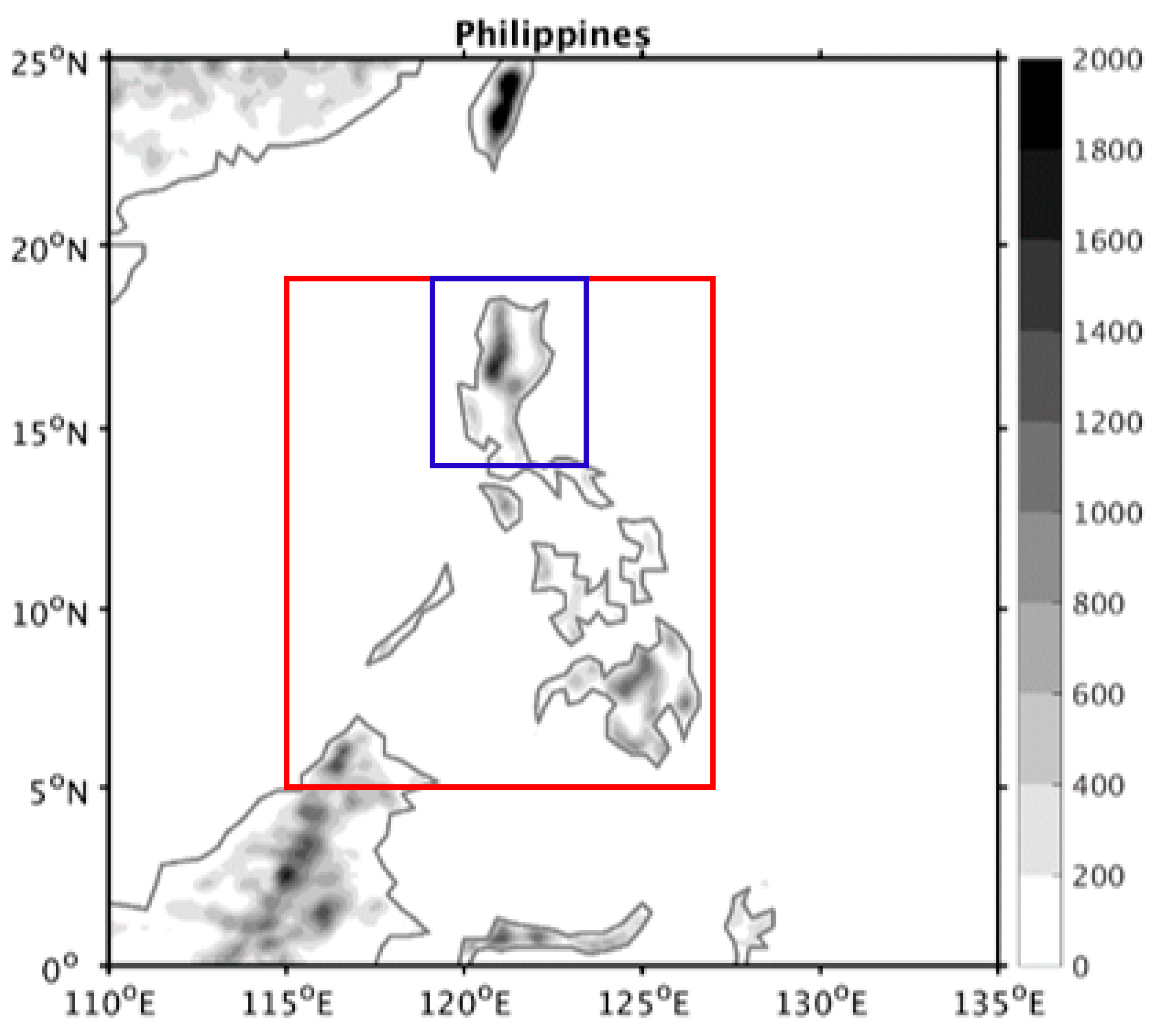

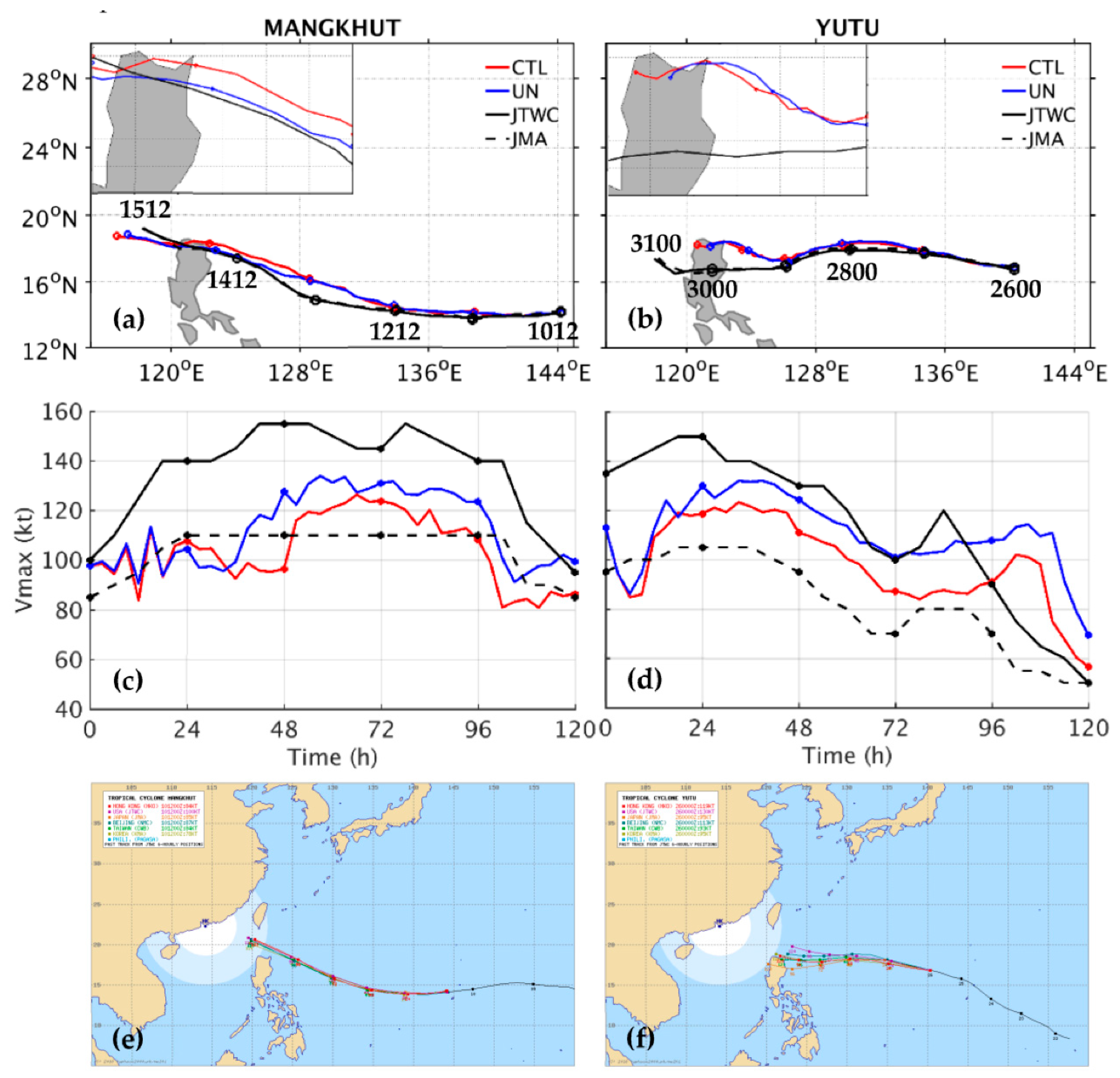
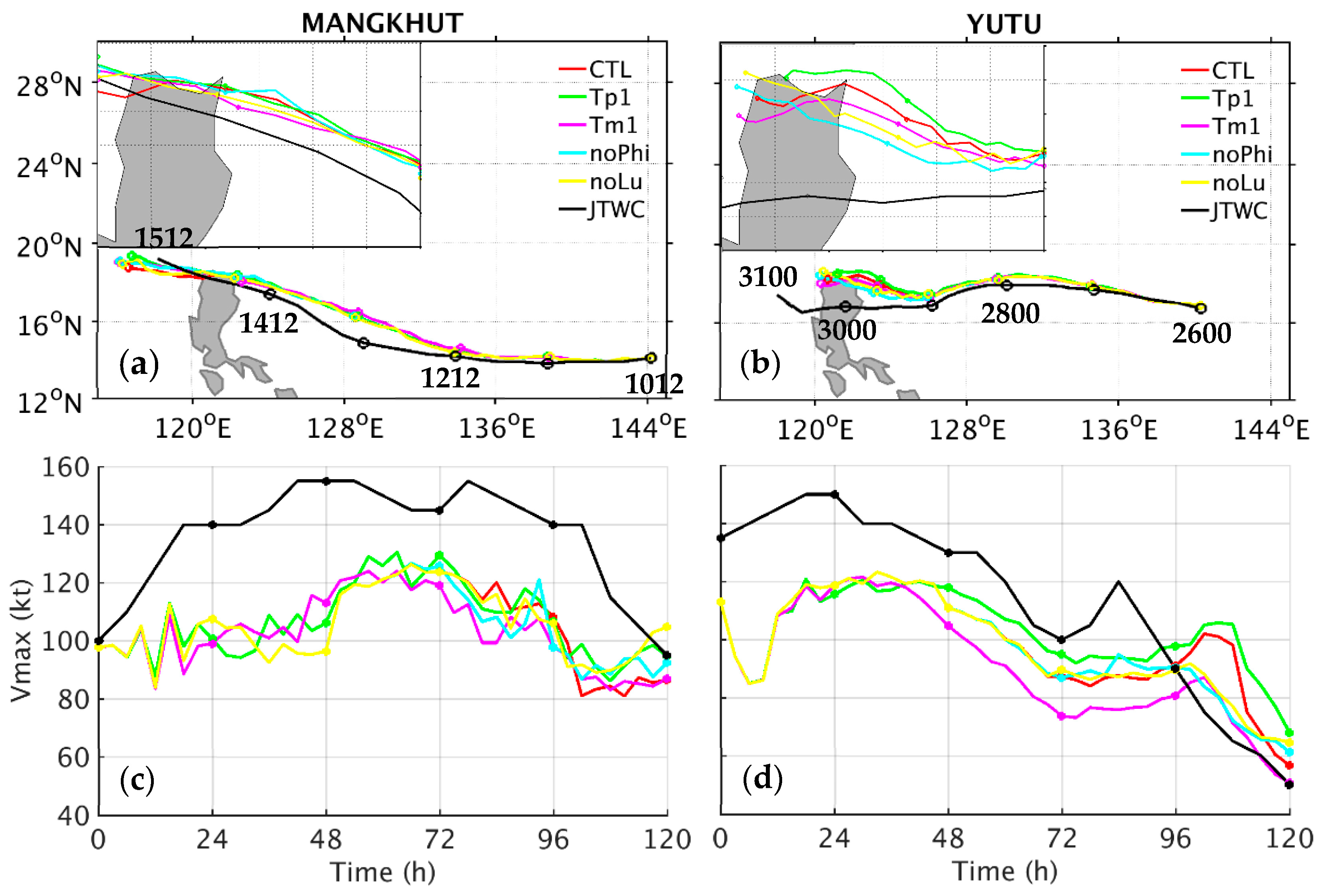
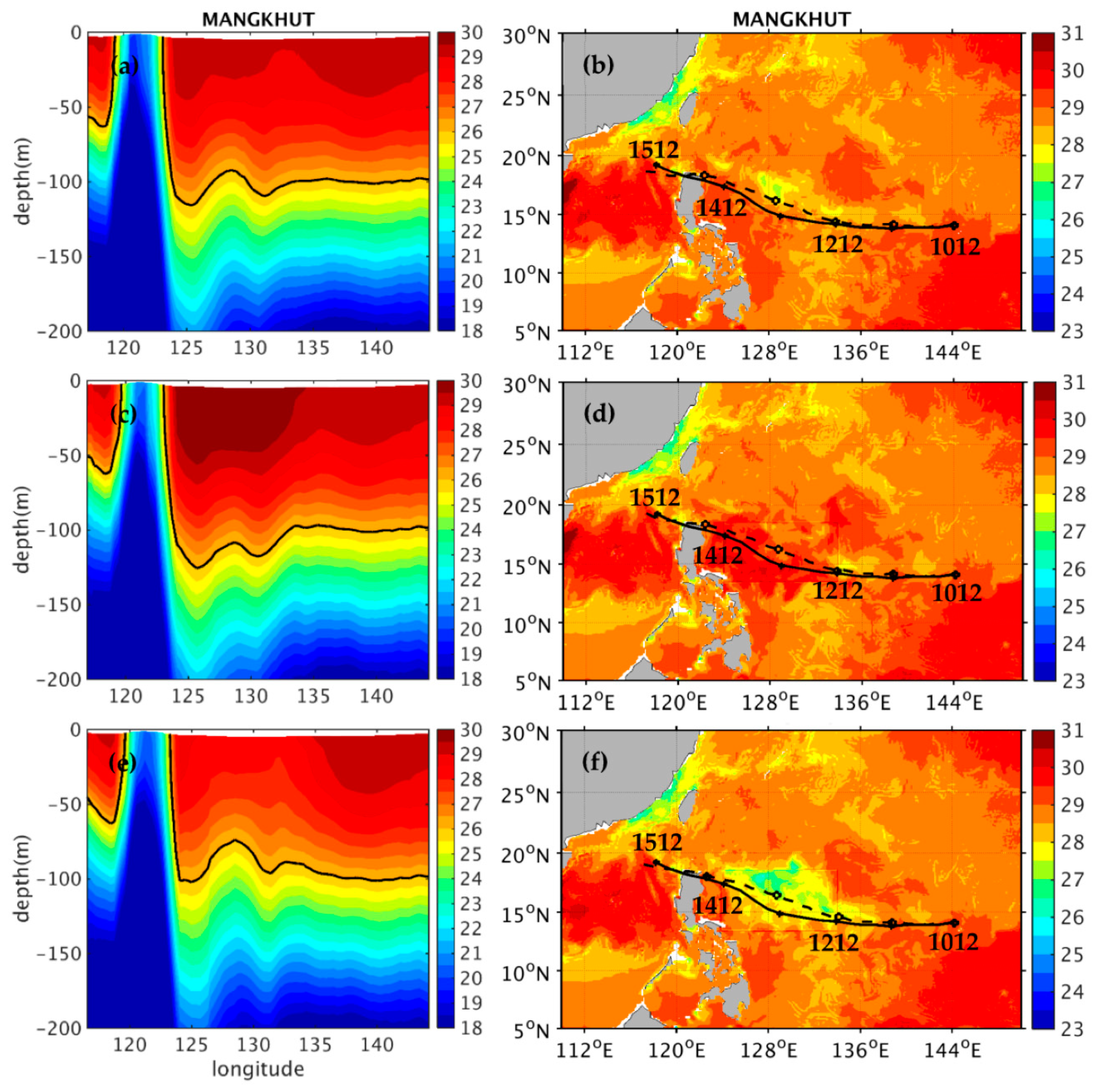

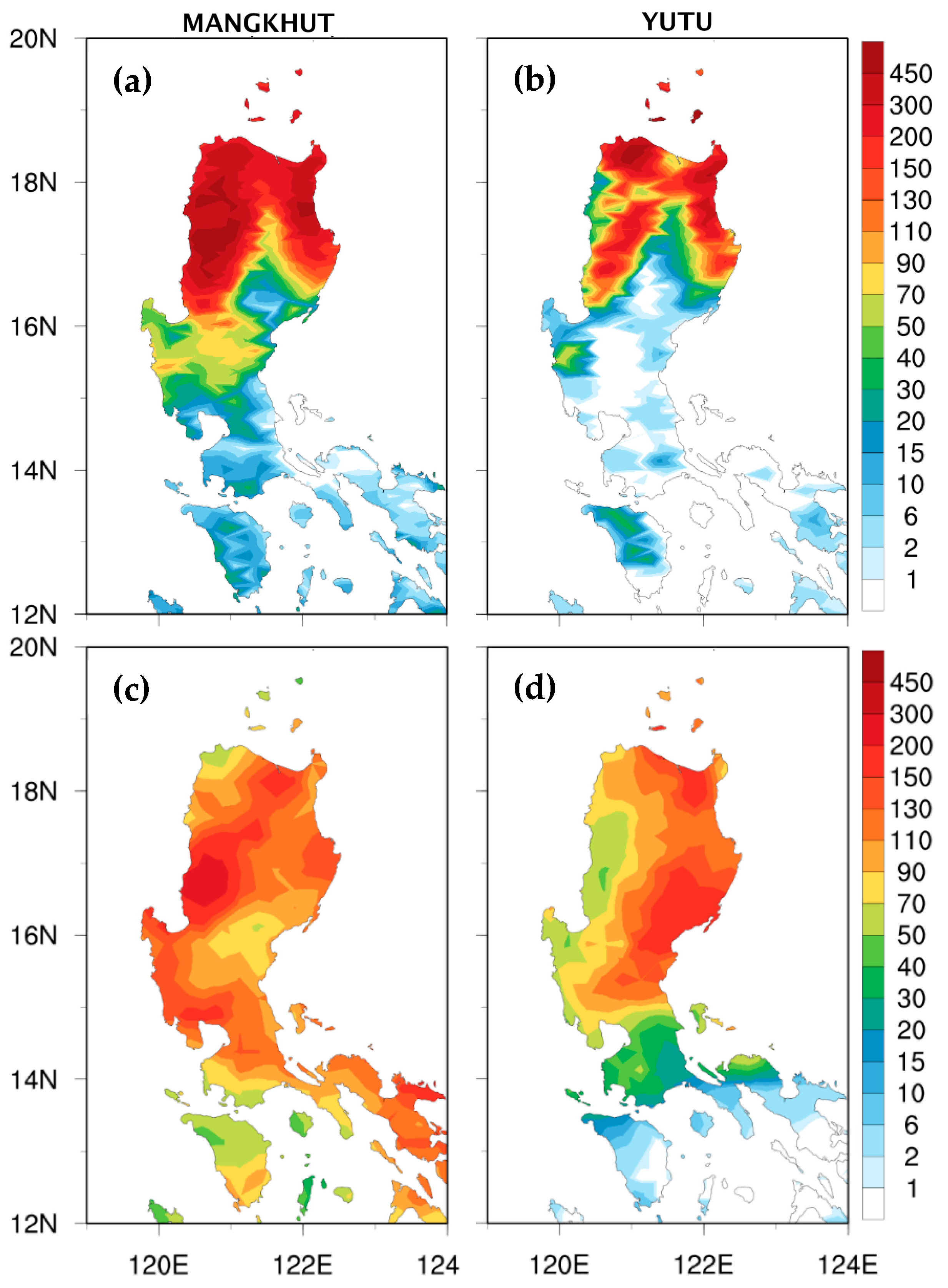
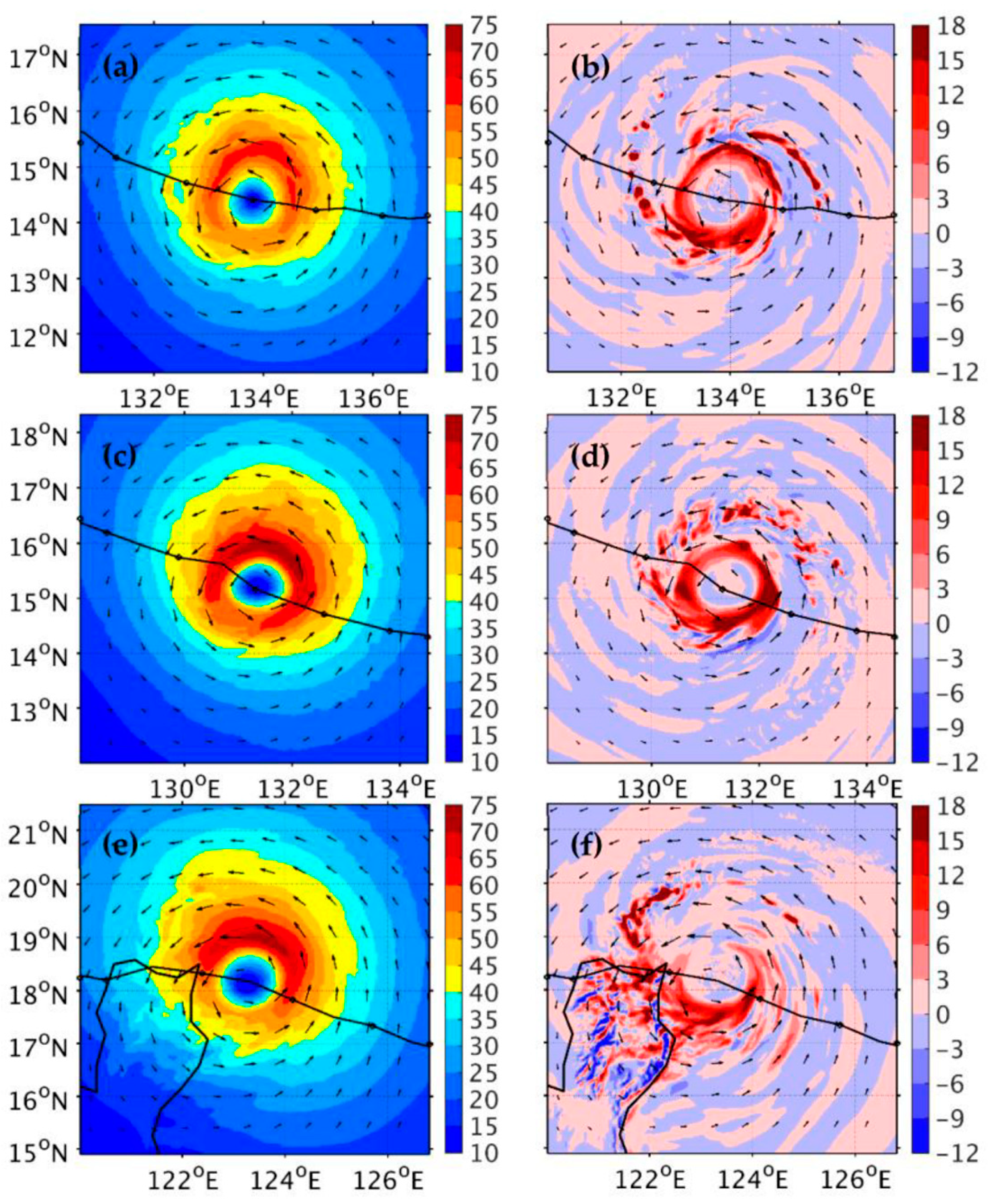
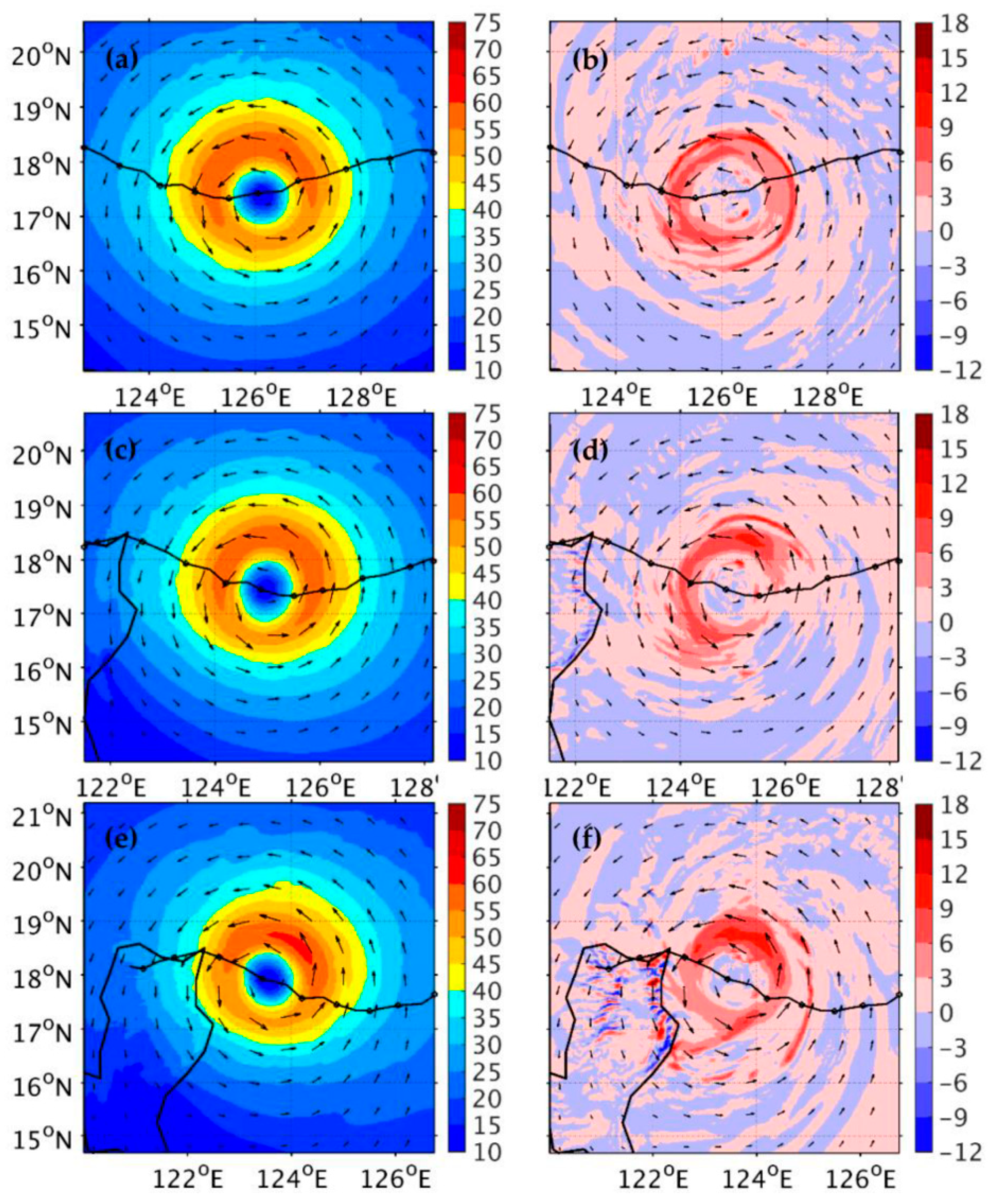
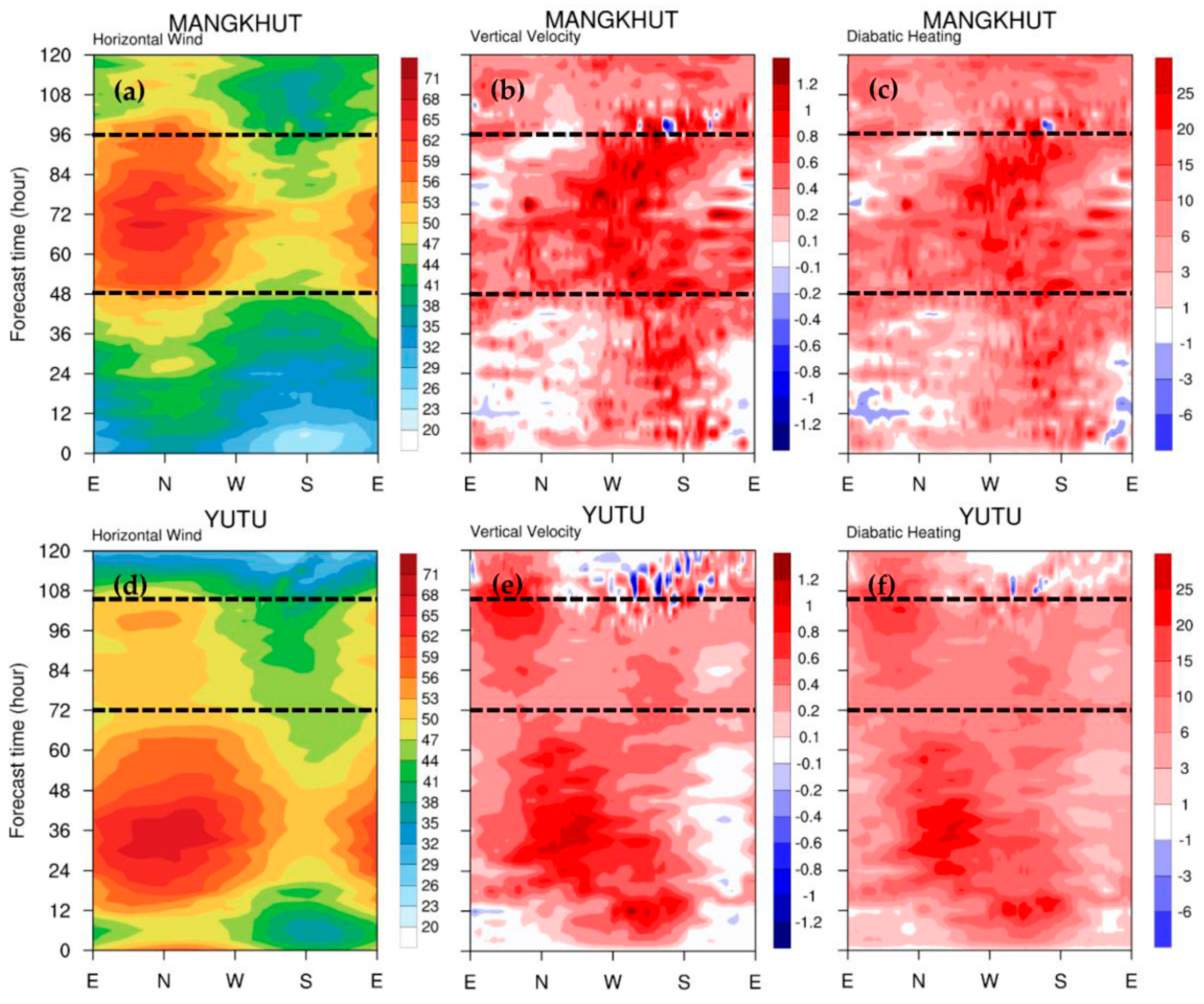
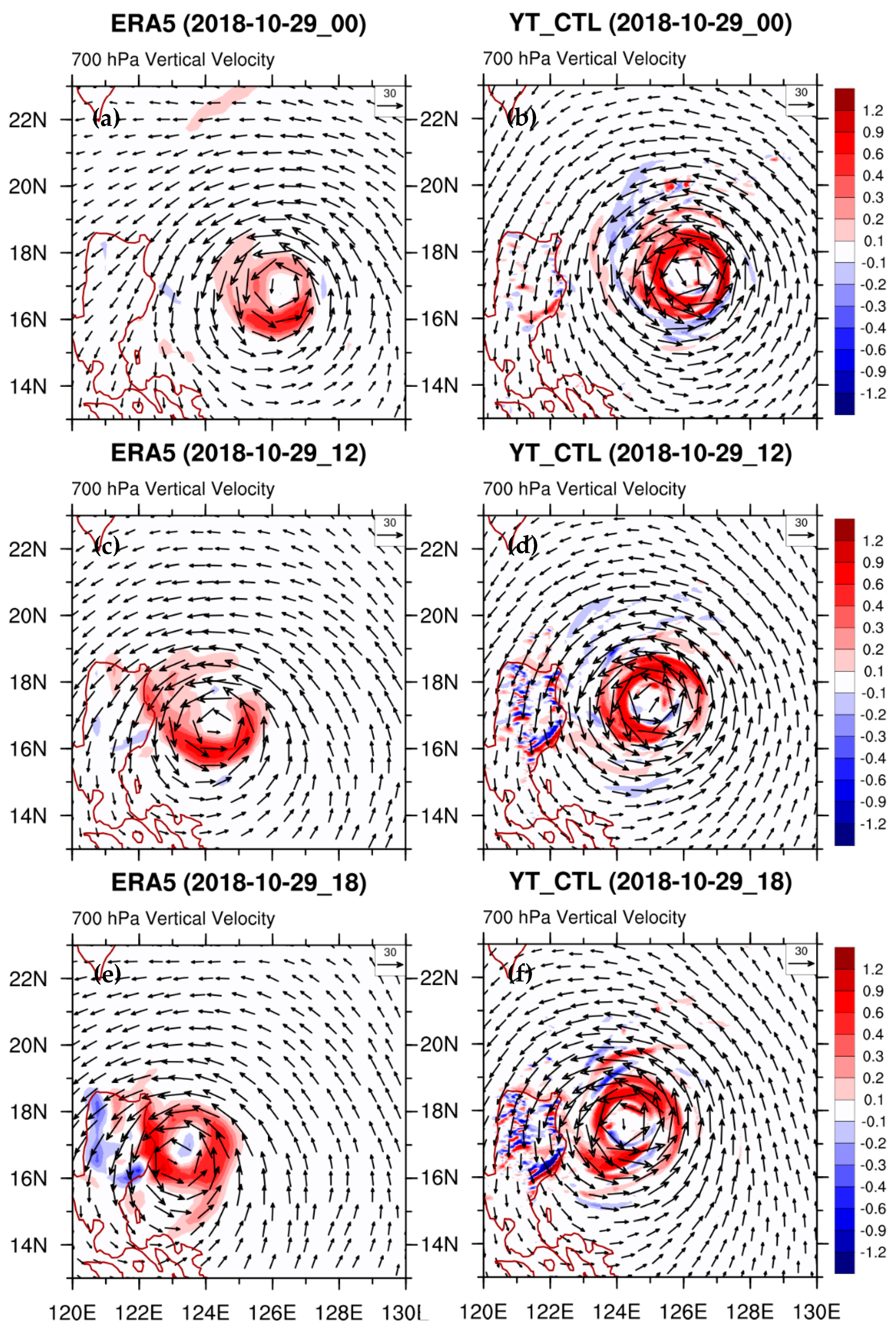

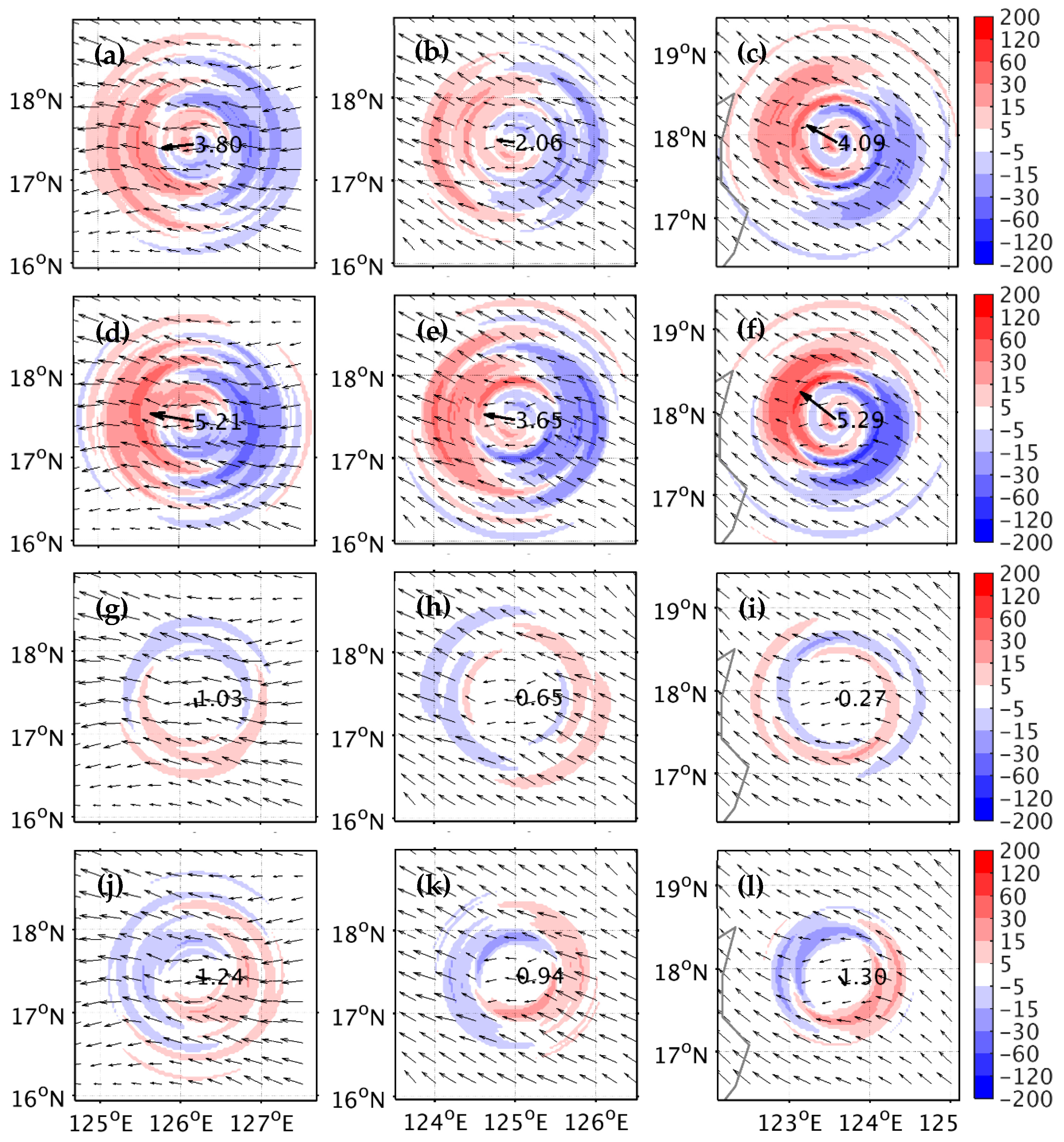
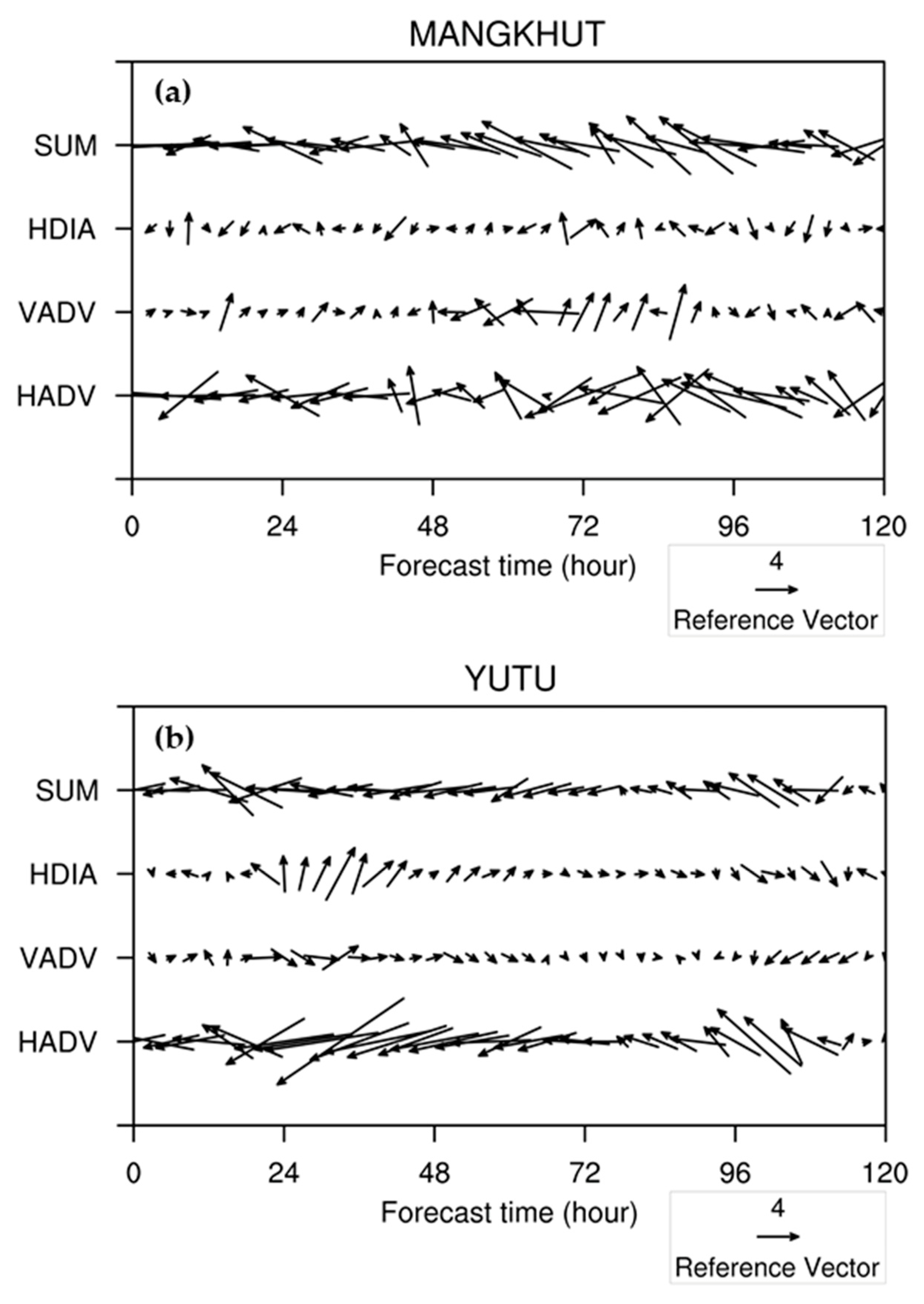
| Experiments | Cloud Microphysics | Cumulus Parameterization | PBL Scheme | |
|---|---|---|---|---|
| KF–GFS | FA | Ferrier-Aligo | Kain-Fritsch | GFS |
| WSM6 | WSM6 | Kain-Fritsch | GFS | |
| Thom | Thompson | Kain-Fritsch | GFS | |
| EtaH | Eta HWRF | Kain-Fritsch | GFS | |
| TF | Tropical-Ferrier | Kain-Fritsch | GFS | |
| KF–YSU | FA | Ferrier-Aligo | Kain-Fritsch | YSU |
| WSM6 | WSM6 | Kain-Fritsch | YSU | |
| Thom | Thompson | Kain-Fritsch | YSU | |
| EtaH | Eta HWRF | Kain-Fritsch | YSU | |
| TF | Tropical-Ferrier | Kain-Fritsch | YSU | |
| SAS–GFS | FA | Ferrier-Aligo | SAS | GFS |
| WSM6 | WSM6 | SAS | GFS | |
| Thom | Thompson | SAS | GFS | |
| EtaH | Eta HWRF | SAS | GFS | |
| TF | Tropical-Ferrier | SAS | GFS | |
| Experiments | Include Terrain | Ocean Temperature Changes | Air–Sea Coupled |
|---|---|---|---|
| CTL | Yes | No | Yes |
| UN | Yes | No | No |
| Tp1 | Yes | Increase by 1 °C | Yes |
| Tm1 | Yes | Decrease by 1 °C | Yes |
| noPhi | No (the Philippines) | No | Yes |
| noLu | No (Luzon) | No | Yes |
Publisher’s Note: MDPI stays neutral with regard to jurisdictional claims in published maps and institutional affiliations. |
© 2021 by the authors. Licensee MDPI, Basel, Switzerland. This article is an open access article distributed under the terms and conditions of the Creative Commons Attribution (CC BY) license (https://creativecommons.org/licenses/by/4.0/).
Share and Cite
Nguyen, T.-C.; Huang, C.-Y. A Comparative Modeling Study of Supertyphoons Mangkhut and Yutu (2018) Past the Philippines with Ocean-Coupled HWRF. Atmosphere 2021, 12, 1055. https://doi.org/10.3390/atmos12081055
Nguyen T-C, Huang C-Y. A Comparative Modeling Study of Supertyphoons Mangkhut and Yutu (2018) Past the Philippines with Ocean-Coupled HWRF. Atmosphere. 2021; 12(8):1055. https://doi.org/10.3390/atmos12081055
Chicago/Turabian StyleNguyen, Thi-Chinh, and Ching-Yuang Huang. 2021. "A Comparative Modeling Study of Supertyphoons Mangkhut and Yutu (2018) Past the Philippines with Ocean-Coupled HWRF" Atmosphere 12, no. 8: 1055. https://doi.org/10.3390/atmos12081055
APA StyleNguyen, T.-C., & Huang, C.-Y. (2021). A Comparative Modeling Study of Supertyphoons Mangkhut and Yutu (2018) Past the Philippines with Ocean-Coupled HWRF. Atmosphere, 12(8), 1055. https://doi.org/10.3390/atmos12081055






